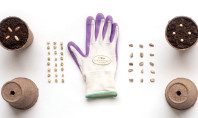Car Care Aware
This was quite the winter, wasn’t it? If it wasn’t record-breaking snowfall in January, it was slick, icy roads, likely coated with road salt and brine. So with all that winter buildup, how do we make sure our cars are ready for Spring?
Taking care of some basic maintenance issues now can avoid them from turning into expensive and dangerous problems.
Jack Dungan, Service Director of Brown-Daub Chevrolet of Nazareth has some valuable tips to share. “Frigid temperatures and harsh road conditions take a serious toll on our transportation. Taking care of some basic maintenance issues now can avoid them from turning into expensive and dangerous problems,” he says. Let’s run down a list of some car care basics.
1. Check your tire pressure, tread and alignment. Many new cars have TPMS (tire pressure monitoring systems), which signal you when you have low tire pressure. Don’t ignore those warning lights! “To check tread depth, simply place the edge of a penny into the tread of each tire, near the center. If the tread doesn’t cover any portion of Honest Abe’s head, you likely going to need new tires,” Dungan shared.
Also – don’t forget about your spare tire! Get your tires balanced if you’re feeling anything but a smooth ride when you drive.
Having your tires rotated is another good idea, as that helps your tires wear evenly. Potholes and other winter road hazards aren’t good for your car’s suspension. “If you notice your car constantly pulls to one side or doesn’t drive straight ahead when your steering wheel is centered, get it checked,” he added.
2. See clearly. A change of seasons is a good time to check your windshield wiper blades. Have they been streaking or chattering? Most blades are good for six months, and some can go longer. Your visibility is important, so don’t short-change yourself by trying to go another season without replacing them. This isn’t too hard to do yourself, and most auto parts stores have guides to ensure you’re buying the correct replacements.
3. Be seen by others. When was the last time you checked to see if all your bulbs were working properly? Turn on your lights and walk around your car. Be sure to check your marker lights and license plate lights, in addition to your headlights and taillights. Get a friend to put his foot on the brakes and be sure your brake lights (and the center high-mounted one, too) are all functioning properly. Check your high and low beams, and the turn signals. This includes back-up lights, too!
4. Check those fluids. Keep an eye on important fluid levels under the hood. These include your radiator system, oil, transmission, and windshield washer fluid. You’ve probably used a lot of washer fluid this past winter, so you may want to keep some on hand in your garage for an easy topping off of the tank. Dungan shares this tip: “We want good [fresh, new] fluids conditioning your old parts, rather than old fluid trying to do the job. It has always been my personal simple philosophy to follow.” He also suggests you consult your owner’s manual to find out how to check the levels on your particular model.
5. Give your baby a nice bath. After a long winter, your vehicle needs a good, thorough cleaning. Pull out that garden hose, and get a good quality car wash concentrate. It’s best to wash from the ‘top down’ – meaning you wet your car down, and then clean the roof, then the trunk and hood, and then the sides, and the wheels last. This method lets all the dirty water wash away from the car, and you’re not running dirty water over clean areas. Also, don’t forget the bottom of your doors – they can really get coated with grime. Road salt can really do damage to your car, so this may be when you go to a carwash for a thorough undercarriage cleaning. Finish things up with a good coat of quality car wax.
6. Clean the interior. Cold weather is the time when we don’t worry about extra stuff in the car, primarily because it’s too cold to clean it out. Take time to declutter and throw out garbage, and store the ice scraper until next season. Give those mats a good cleaning, and use a steam cleaner to really remove road salt from your interior carpets. Do you carry sandbags or other heavy items in the trunk to improve how your rear-wheel drive car handles? Taking extra weight out of your car can also increase your gas mileage.
7. Test your batteries, spark plugs and wires. These items work together to get your car running, and really work hard in the cold months. Frigid temperatures can compromise performance. Dungan adds that “if your battery is more than four years old and if it sometimes takes more than a few seconds to start your motor, have it checked.”
8. Change your oil. One of the cheapest ways to ensure your car will last it to change the oil and filter. Check your owner’s manual for the proper service interval. There are summer-weight oils and winter-weight ones, too. This can add to a smoother running engine, and better gas mileage too. If you do your own oil changes, be sure to properly dispose of your used oil.
9. Clean the inside of your windows, not just the outside! A film develops on the inside of your car glass, and can obstruct your view. This overlooked step will greatly improve your visibility, and you’ll also cut down on glare.














